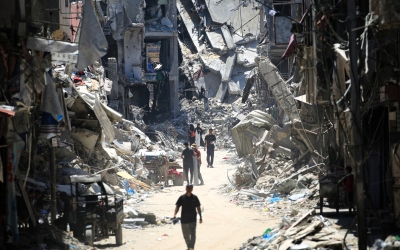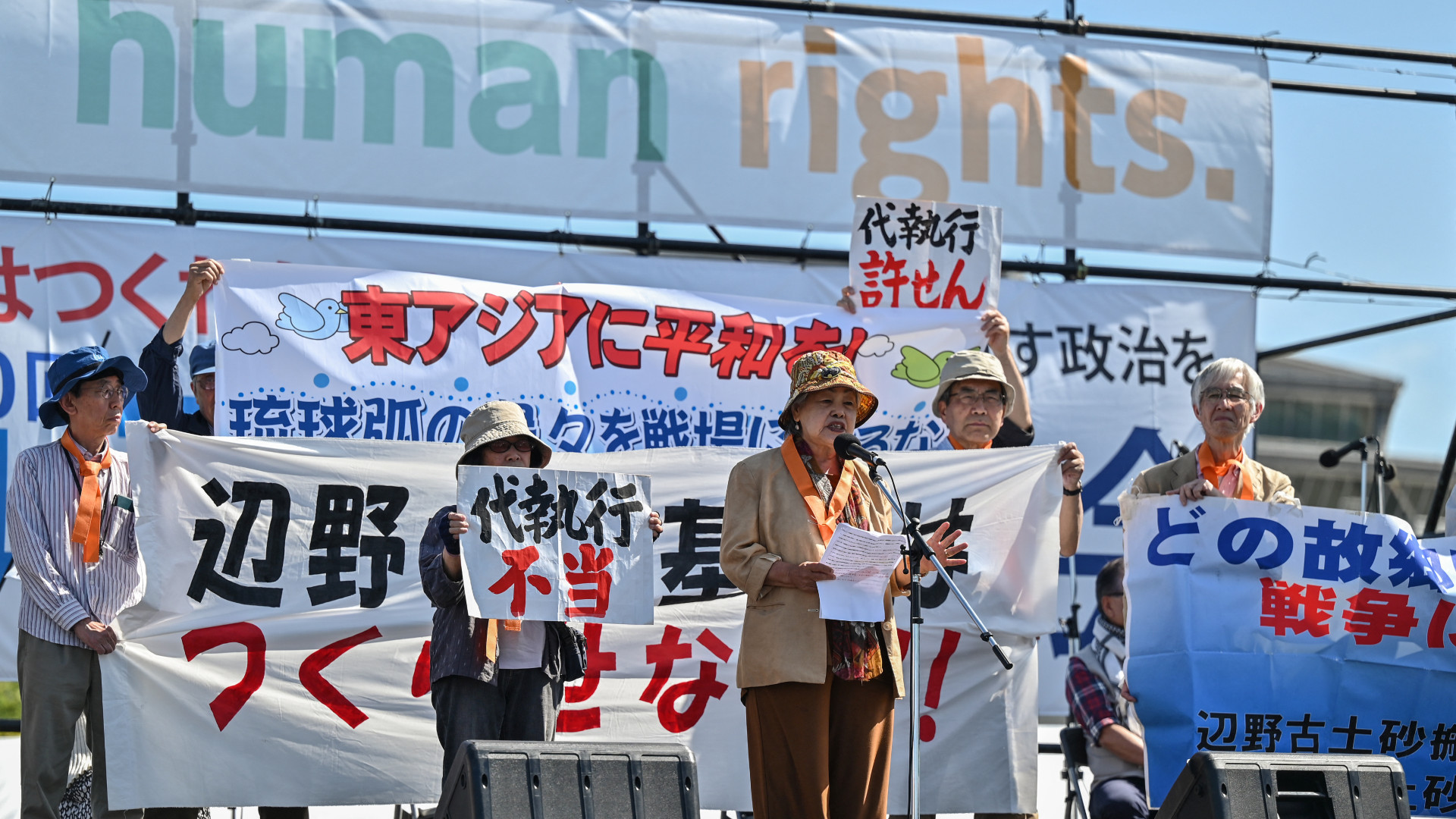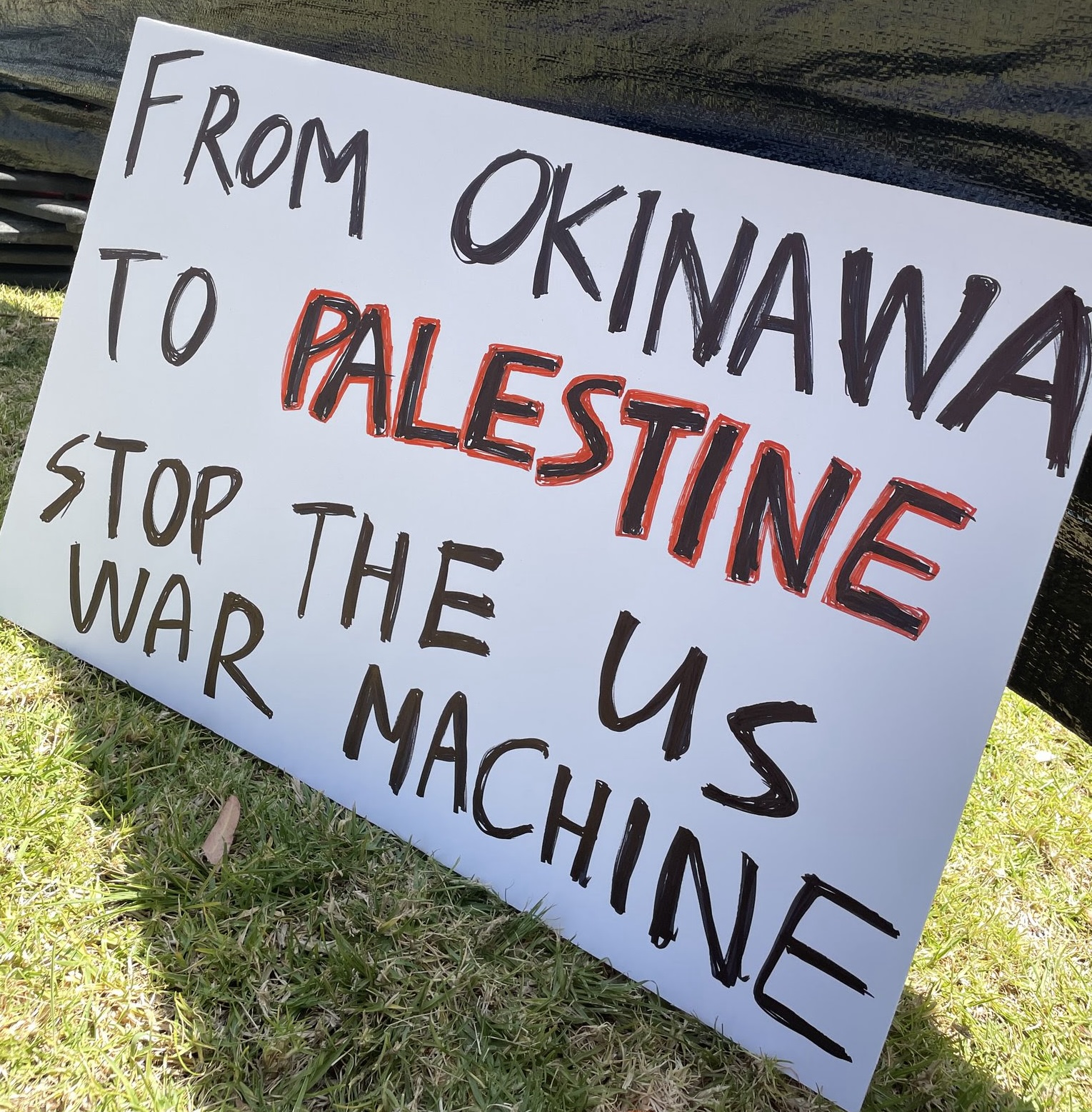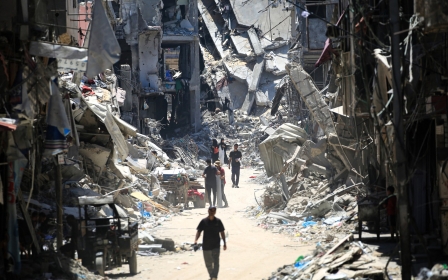From Okinawa to Palestine: How the US military machine connects occupied territories
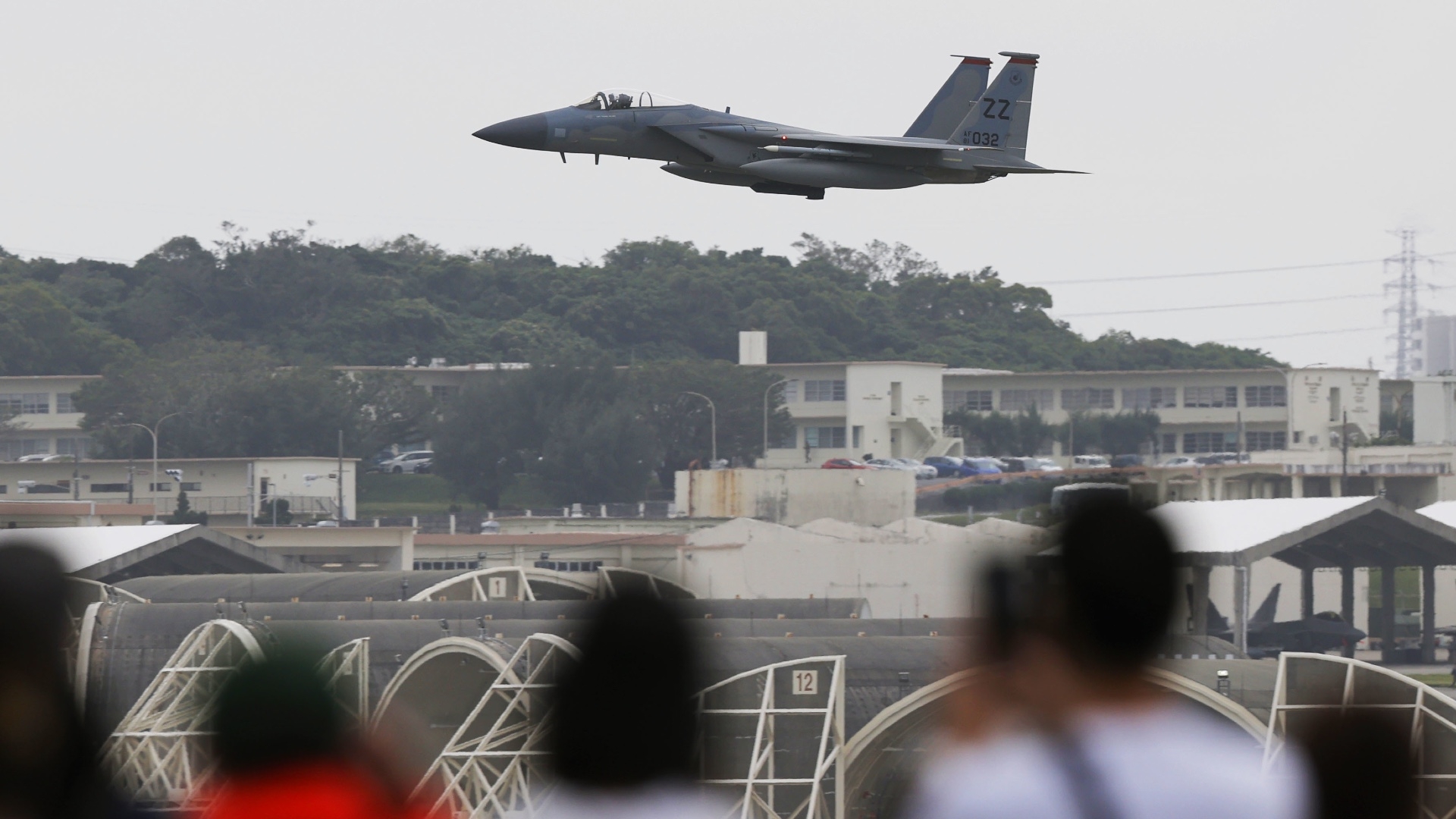
In the past two weeks alone, Israel has perpetrated three massacres in Gaza that managed to shock the world and trigger widespread condemnation.
Flooding social media were scenes that the head of Unrwa called "hell on earth" and Doctors Without Borders described as "apocalyptic".
A raging inferno engulfing a camp for displaced Palestinians, a headless child, dismembered limbs, and scores of maimed and burnt bodies appeared against a soundtrack of explosions and the piercing screams of terrified women and children.
Even those who have closely followed the daily horror show in Gaza over the last eight months - the mass civilian casualties and total destruction of its infrastructure - could not fathom the savagery of dropping a 110kg bomb on plastic tents.
Yet for US officials, the 26 May Rafah tent massacre, which killed 45 people and injured more than 200 others, did not cross President Joe Biden's "red line" for halting weapons shipments.
New MEE newsletter: Jerusalem Dispatch
Sign up to get the latest insights and analysis on Israel-Palestine, alongside Turkey Unpacked and other MEE newsletters
With no accountability, Israel has continued its genocidal campaign in Gaza unabated - as part of a settler colonial project to eliminate native Palestinians that began seven decades ago.
The following week, on 6 June, an Israeli air strike on al-Sardi Unrwa school killed around 40 displaced Palestinian civilians, including children. Two days later, on 8 June, the Nuseirat camp was brutally assaulted by land and air, killing 274 Palestinians.
The harrowing attacks have placed a spotlight on the role of US-supplied weapons and munitions in perpetrating a war that has killed at least 37,296 Palestinians and injured more than 85,000 others since 7 October 2023.
Indeed, US weapons shipments are key to Israel's genocidal violence - and they reveal the sprawling network of the US military war machine that connects settler colonial and militarist violence on two occupied lands, Okinawa and Palestine.
Shared weapons systems
All three recent strikes on Palestinian civilians in Gaza were carried out using US-manufactured weapons.
Both weapons experts and images captured revealed that the explosives used in Rafah and the UN school were US-made GBU-39 small-diameter bombs (SDB). The GBU-39 is a 110kg guided air-to-surface munition manufactured by defence contractor Boeing since 2005.
Since 7 October, the US and Israel have worked on various deals to manage the exchange of weapons and the aircraft systems to carry them
According to the US Air Force's fact sheet, the F-15E Strike Eagle is the only aircraft outfitted with the SDB weapons system. Future platforms designated for SDBs include the F-16 Fighting Falcon, F-117, B-1 Lancer, B-2 Spirit, F-22 Raptor, and the F-35 Lightning II.
The SDB is one of several weapons used in the Air Force Research Laboratory's (AFRL) Golden Horde programme, which was launched in 2021.
Intended to advance Networked, Collaborative and Autonomous (NCA) weapons capabilities, the programme uses two weapons systems: the Collaborative Miniature Air-Launched Decoy (CMALD) and the Collaborative Small Diameter Bomb I (CDSB-I), the latter being a modified version of the GBU-39 SDB.
Since 7 October, the US and Israel have worked on various deals to manage the exchange of weapons like the SDB and the aircraft systems to carry them.
In January, the two nations signed a massive arms deal that included the supply of F-35 and F-15 fighter jets, the two systems equipped or designated for the SDB weapons system. In April, the US Congress approved an additional $26bn in aid to Israel, including $5bn to bolster air defences and bundle weapons shipments.
'Arsenal of democracy'
One weapon that has been frequently mentioned since Israel declared war on Gaza has been the Joint Direct Attack Munition, or JDAM for short.
Manufactured by Boeing, JDAM was developed in 1993 after the Gulf War and uses GPS locators to counter the effects of dust clouds in targeting systems. It can convert unguided "dumb bombs" to guided "smart bombs", meaning that the bombs can be remotely controlled and navigated.
The Israeli military has relied on it in Gaza since October and has killed hundreds of Palestinians in densely populated areas.
Follow Middle East Eye's live coverage of the Israel-Palestine war
The US military first released JDAM in a fleet squadron drop by the Hornet fighter aircraft, which launched from the USS Kitty Hawk in Yokosuka, Japan and deployed to Okinawa, Japan's fifth largest island, on 22 August 1999.
Since its deployment, it has been used in all US wars abroad, including Iraq, Afghanistan, Syria, and Yemen, and has been sold to Ukraine in 2023 for use against Russia.
In two incidents last October, Israel deliberately targeted civilian populations and residences in the central Gaza city of Deir al-Balah with JDAM bombs.
JDAM bomb fragments were found following Israeli air strikes on 10 October and 22 October, both of which resulted in the deaths of many civilians.
Recent protests against Israel's war in Gaza on US college campuses caused the Biden administration to delay the sending of JDAM units to Israel despite the US government's continued support for Israeli military assaults.
On 7 May, Republican Congresswoman Ann Wagner of Missouri called on Secretary of State Anthony Blinken to speed up the delivery of JDAMs because they are manufactured in her St Louis district.
During Blinken's testimony before the House Foreign Affairs Committee on 22 May, Wagner doubled down on her demand that the Biden administration send 6,500 JDAMs to Israel. If weapons sales to Israel were paused, she insisted, her constituents' livelihoods and their ability to pay for daycare, car payments, or mortgages would be threatened. Wagner further asserted that the US weapons industry is the "arsenal of democracy".
Lethal weapons supply
The US uses its massive network of military bases worldwide to store its weapons and aircraft, including at the Kadena Air Force Base in Okinawa, Japan.
In April 2023, the US deployed a squadron of Lockheed Martin's F-35 Lighting II fighter jets to replace Boeing's F-15s that are gradually being phased out. The newly released jets first arrived at Kadena, the largest US base in Asia.
This network of US military bases is one way that Japan has circumvented Article 9, or the "pacifist clause", of its post-World War Two constitution.
Written by the US following the Japanese surrender, the Japanese constitution included a pacifist clause, currently in debate, that explicitly bans the sale or transfer of weapons to any state engaged in active warfare, such as Israel. It further prohibits the deployment of the Japanese military into active combat zones.
In 2014, then-prime minister, Shinzo Abe, revised Japan's arms policy to allow the sale of individual weapons components, defence technology, and equipment rather than fully assembled products.
However, a series of political manoeuvres in December 2023 by current prime minister, Fumio Kishida, expanded Japan's ability to export arms further, allowing it to send finished weapons such as the surface-to-air Patriot guided missiles produced in Japan and used in countries like Israel and Ukraine.
Through its licensing agreements with eight countries, including the US, UK, France, Germany, Italy, Belgium, Sweden, and Norway, Japan has helped bolster the global war machine. Japan can now replenish US weapons stockpiles, which in turn furnish Israel's stock of fighter aircraft and missiles.
Despite mounting popular pressure, the Japanese government has continued to militarise and increase its own arsenal
Following Ukraine's footsteps, in 2022, the Japanese Self-Defense Forces (JSDF) bought Israeli and US-made attack drones to deploy in Okinawa that could be used in actual warfare against a potential Chinese threat.
Just this week, Japan and the US held their first talks to enact a new framework that will deepen their defence-industrial collaboration to replenish US stockpiles of anti-tank weapons.
This comes after the boycott, divestment, and sanctions (BDS) movement in Japan, which has gained strength amid Israel's genocide in Gaza, forced Japanese companies to break their ties and "strategic partnership" with the Israeli defence contractor Elbit Systems.
Despite mounting popular pressure, however, the Japanese government has continued to militarise and increase its own arsenal while playing the role of a US puppet in serving its imperialist interests.
Kishida's remarks before Congress in April only reinforced this image, particularly his tone-deaf praise of the US's "indispensable" role in world governance and policing.
These weapons supply networks and international arms agreements are just some of the ways Japan has supported the expansion of the US military machine since 1945.
Land theft and dispossession
The current genocide in Gaza continues a long history of Israeli occupation, dispossession and displacement of Palestinians that stretches back to the Nakba in 1948.
Just as the State of Israel was built on the ethnic cleansing of Palestinians, in the Ryukyu Islands, Okinawans also face the brutality of settler violence.
The Japanese annexation of the once sovereign Ryukyu Kingdom in 1879 introduced Japanese imperialism to the islands, which led to their militarisation under the Japanese emperors.
The 82-day Battle of Okinawa, fought between the US military and the Imperial Japanese Army in 1945, resulted in 150,000 Okinawan civilian deaths - a quarter of the population - and the displacement of hundreds of thousands of Okinawans.
In the aftermath of the war, Japan's Emperor Hirohito brokered a deal that sold Okinawa and handed administrative control of the prefecture to the United States Civil Administration of the Ryukyu Islands.
During the American occupation of Japan from 1945 to 1972, a land acquisition law allowed US forces to confiscate land from its owners, furthering the systematic dispossession of Okinawans. This blatant land theft became locally known as "Bulldozers and Bayonets".
The legacies of these dispossessions continue today. Although Okinawa constitutes only 0.6 percent of Japan's total land mass, it hosts more than 70 percent of the US military facilities in the country.
The US military's land seizures established the foundations for its network of military bases in Asia and the Pacific. Throughout the Cold War, the US reshaped the image of Okinawa, referring to it as the "Keystone of the Pacific" for its strategic location.
That discourse continues today, with Kadena Air Base being recognised as the "lynchpin" of US power in Asia. The base is home to the US Air Force's 18th Wing, which operates fighter jets like the F-15 Eagle, the F-22 Raptor, and now the F-35.
Throughout the nearly 80 years of US military occupation, the US has used Okinawa to store much of its inventory, including the use of Kadena as a strategic bombing station for the B29 and B47 bombers during the Korean War and, in recent years, as a station for the F-15s used in the Gulf War.
A recent public opinion poll has once again shown that the majority of Okinawans oppose US military bases. Yet despite decades of protest and a vocal anti-base movement, the people's will is ignored, and Okinawa and the Ryukyu Islands more broadly continue to be used as an inventory and supply station for the US military.
Beyond the US, Okinawa's enduring struggles represent the legacy of Japan's colonisation of the former Ryukyu Kingdom. On 23 June, Okinawans will commemorate "Irei no hi", Okinawan Memorial Day, to remember those killed in 1945.
Free Okinawa, free Palestine
Just days after Okinawans solemnly mark a historical massacre, the US will lead defence training exercises on military-occupied lands nearly 8,000km away across the Pacific.
Touted as the largest international maritime exercise, Rim of the Pacific, or Rimpac, serves as a showroom for the latest US military weaponry.
This summer, 29 countries are invited to bomb the occupied Kingdom of Hawaiʻi
This summer, from 26 June to 2 August, 29 countries are invited to bomb the occupied Kingdom of Hawaiʻi, including at Pohakuloa Training Area, a US military base, on the island of Hawaiʻi.
Among them are Japan and South Korea, which are forming a trilateral partnership with the US and participating in joint military exercises known as "Freedom Edge".
Other repressive states like Sri Lanka, which has committed widespread human rights abuses, and Israel, which stands accused of genocide in the International Court of Justice, are also invited to Rimpac ostensibly as potential customers.
But perhaps most disappointing is the participation of Chile, home to the largest Palestinian population outside of the Arab world with roughly half a million, in the Rimpac exercises destroying the lands and oceans around Hawaiʻi.
A petition for 27 countries to withdraw from Rimpac and end cooperation with the US and Israel over Gaza garnered over 8,100 signatures from more than 70 organisations and 92 countries.
The shared experience of settler-colonial dispossession, particularly the role of the US, helps explain why many Okinawans support a free Palestine and why Palestinian doctor Salim Anati observed that "both Palestine and Okinawa are under the same situation of occupation".
The dedicated struggle that both Indigenous people have waged against military occupation and colonialism even sparked the recent "Okinawa to Palestine" liberation movement.
The calls for self-determination are only getting louder and more determined, with many believing that the fates of both peoples are ultimately intertwined.
From Okinawa to Palestine, everyone has the right to live in dignity and freedom from settler-colonial occupation and the violent military network that enables it.
The views expressed in this article belong to the authors and do not necessarily reflect the editorial policy of Middle East Eye.
Middle East Eye delivers independent and unrivalled coverage and analysis of the Middle East, North Africa and beyond. To learn more about republishing this content and the associated fees, please fill out this form. More about MEE can be found here.


